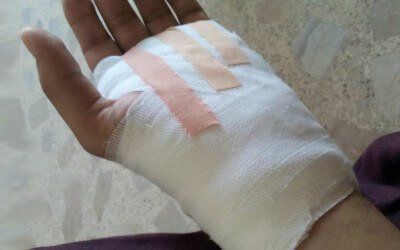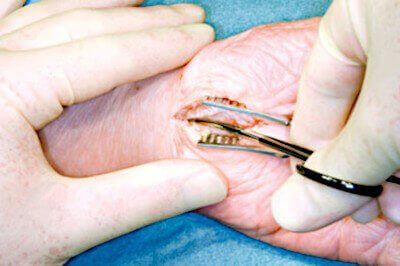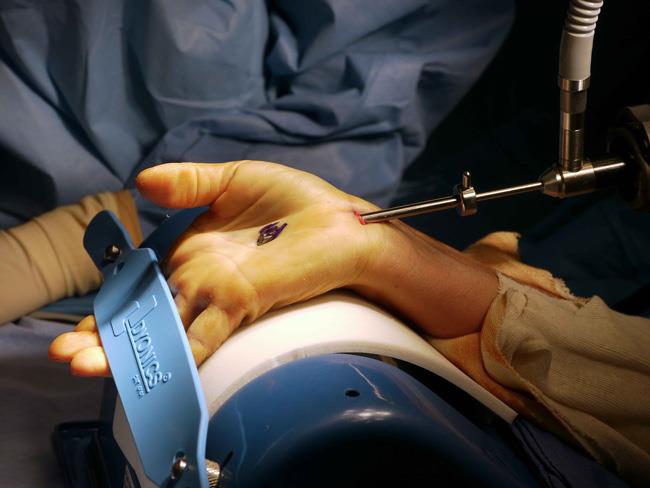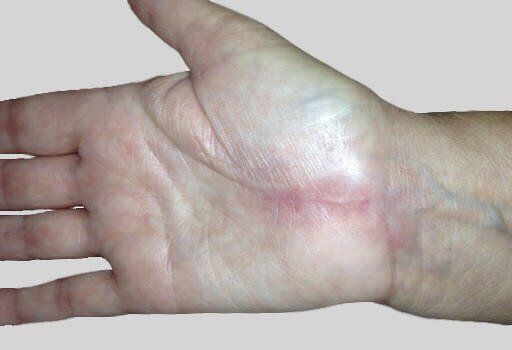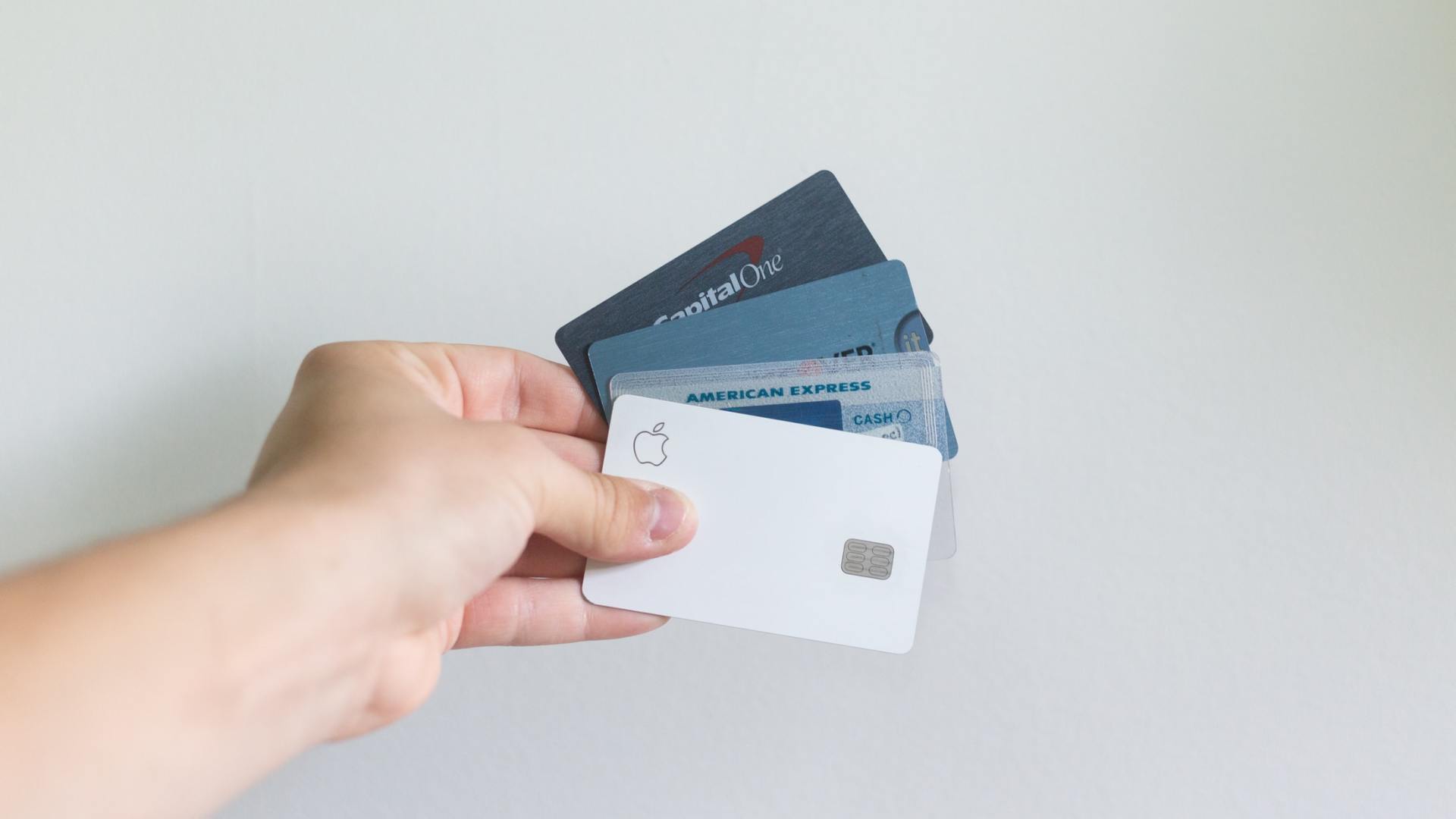All About Your Carpal Tunnel Surgery Scar
Table of Contents
- Overview
- Introduction
- Type of procedure & size of the carpal tunnel surgery scar
- Open carpal tunnel release surgery
- Endoscopic carpal tunnel release surgery
- Pros & cons of each technique
- The 4 main problems with a carpal tunnel surgery scar
- Pain and tenderness
- Diminished hand function
- The resulting cosmetic scar
- The "financial scar"
- Summary
- FAQs
- About
Overview
When patients undergo
carpal tunnel release surgery the doctor makes either one or two incisions on the palm of the hand. A carpal tunnel surgery scar will
always
result after having this operation. But the incision can be large or small. The incision size determines the
size of your scar. Therefore, the
type of operative procedure you have determines the size of the incision and the size of your resulting scar. If everything goes right, this permanent reminder of your operation will be the only thing left of carpal tunnel's pain and
numbness. But if things don't go right, any number of issues also may leave a permanent reminder.
Introduction
Any time your skin is cut (by accident or a scalpel), scarring occurs both
above and below
the skin. Scarring below the skin is invisible and usually proceeds without incident. But in some cases it can cause
complications. This is what might happen as a result of carpal tunnel surgery. In this scenario, the most common complications are usually persistent pain and limited hand mobility.
However, many patients are also concerned with the visible (cosmetic) scarring above the skin. Patients often want to know what the carpal tunnel surgery scar will look like, how it will feel, and how it will change their hand’s appearance. Of course, these are legitimate concerns.
The answers to these questions largely depend on the type of surgery you have.
Type of procedure & size of the carpal tunnel surgery scar
If you are having carpal tunnel surgery, the scar size will be determined by the type of operation you have. You will have one of two types
of operative procedures:
The goal of both procedures is to cut the
transverse carpal ligament inside your wrist joint. Doing so lets the wrist bones snap apart. This provides more room for the
median nerve so it's no longer crushed by the tissues around it. That nerve crushing is what causes all of the
symptoms of carpal tunnel syndrome.
Open carpal tunnel release surgery
Endoscopic carpal tunnel release surgery
Pros & cons of each technique
Doctors use the
open
carpal tunnel release surgery procedure
more often. It's more popular and safer than the endoscopic procedure. See
this article for specific details.
Essentially the open technique is safer because the wide open incision lets the doctor see all of the hand's structures clearly. But the disadvantage is that it's large size damages more tissues in the hand. This causes more
postsurgical pain, more involved
aftercare, longer
recovery time - and of course
- a larger surgery scar.
The endoscopic procedure's big advantage is the reduced trauma caused by the smaller incision(s). And the resultant carpal tunnel surgery scar is much smaller. But this method is not as safe as the open technique because of the limited visibility. As a result, accidentally cutting a nerve or blood vessel can occur.
The post-surgical recovery results and success rates are about the same for both procedures.
The 4 main problems with a carpal tunnel surgery scar
Most doctors use open release surgery to relieve carpal tunnel syndrome. It's an effective and time-tested procedure to relieve the most
severe carpal tunnel symptoms like hand or finger
pain,
numbness, tingling,
weakness, and
shooting electric shocks.
All patients who have this surgery will have a hand scar. Once again, the scar you see on your skin surface is just
one
scar resulting from carpal tunnel surgery. Scar formation also happens
below your skin.
Actually, the scar deep in your wrist tissues is much larger, more spread out, and therefore more medically significant. This is the scar that determines how long your recovery will take. In contrast, the scar above the skin is only a cosmetic issue.
There are 4 main consequences of the carpal tunnel surgery scar. These are:
- Pain and tenderness
- Diminished hand mobility
- The resulting cosmetic scar
- The remaining financial scar
1. Pain and tenderness
After carpal tunnel surgery, scar tenderness and
paresthesia (abnormal sensation on the skin) are completely normal. As the outside scar tissue forms in 2-5 weeks after surgery, you may have
flare-ups of your symptoms. Much of this is a result of post-surgical adhesions under the skin.
Generally, the painful feelings are sudden and brief. They feel like
electricity running through your hand and into your fingers. In fact, for a time, you almost always feel this pain when grasping something.
This is different from any
pillar pain you might feel. That's actually a complication of surgery which causes pain or tenderness adjacent to the visible surface scar.
2. Diminished hand function
Once the doctor stitches your incision closed to complete your carpal tunnel surgery, scar formation begins - above and below your skin. Cutting the transverse carpal ligament requires cutting and displacing many more tissues inside your wrist.
Consequently, this often creates problems with your hand’s function. Actually, there is almost always a direct link between surgery for carpal tunnel and some
loss of grip strength.
Surgery causes a loss of structural integrity inside the wrist joint. As a result, hand function may be diminished right after surgery and even weeks or months later. That’s because of the scarring below the skin. When this happens, tissues bind together with
adhesions. For this reason, wrist and hand movements often become restricted.
Furthermore, as the scar tissue progresses around the flexor tendons, they also bind up. That prevents them from smoothly gliding past each other inside the wrist joint. Consequently, pain and loss of mobility (or range of motion) can follow.
Sometimes patients need a second carpal tunnel release surgery. That's because scar tissue can build up so much that it causes problems deep inside. Hence the name
"revision" carpal tunnel release surgery for the procedure when this happens. It's essentially the same surgery performed all over again.
3. The resulting cosmetic scar
Many people feel the need to apologize for their carpal tunnel surgery scar. This highlights the importance of how we feel about our personal appearance.
In fact, ask any surgeon and they'll tell you that patients considering hand surgery ask one question most often. That is,
"Will my scar be noticeable?" Women in particular tend to ask about this even before asking how much
pain they'll experience (which is the most common question among men).
Indeed, for many, physical appearance is important to their self-esteem. For now, we won’t discuss whether or not this is healthy, just that it’s fact. For such patients who believe their hands are their calling cards, having a carpal tunnel surgery scar is an important matter.
Having a scar affects everybody differently. So don’t be ashamed about being concerned over it. If that’s a main reason to shy away from surgery, so be it. Besides, you have other
non-surgical options that work just as well as surgery.
And none of them leave a scar.
4. The "financial scar"
More than half of patients who have carpal tunnel surgery
are not satisfied with their results by 2 years. Moreover, the
National Institutes of Health
says 50% of doctors don’t follow
practice guidelines
when it comes to carpal tunnel surgery.
That means many doctors don’t bother recommending non-surgical options first. Instead, they perform surgery on their patients from the outset.
As a result,
many people who have carpal tunnel release surgery
actually never needed it. Instead, they could have used reliable, non-surgical therapies which work just as effectively.
And for a lot less money.
In other words, for many unlucky people who had carpal tunnel surgery, scar formation, recovery pain, financial loss, and diminished strength were all
unnecessary.
It’s clear why so many people are not satisfied with their surgery. Just think about what it entails. For instance, consider:
Summary
A carpal tunnel surgery scar is not just a surface reminder of your operation. There's also a lot of scar tissue below the skin - inside your wrist joint. In fact, that inner scar is far more extensive than the one on your skin. Moreover, it’s a primary cause of complications as well as emotional and financial problems.
FAQs
- If my first surgery fails, should I get another (revision) surgery?
Discuss this with your doctor. The probability of a revision surgery being successful is greatly diminished since the first surgery failed.
- Do I have as say in which surgical procedure I get?
Not usually. Your doctor (surgeon) will prefer performing either the open or endoscopic release surgery. Discuss this with him/her before the procedure. If you are insistent upon having a procedure you doctor does not do, it's best to find another doctor who uses that particular procedure.
- Which surgical procedure is best?
There really is no "best" or "worst" procedure. Each has its pros and cons. You should discuss the procedure you are having with your surgeon, and ask why he/she prefers using that procedure.
About


